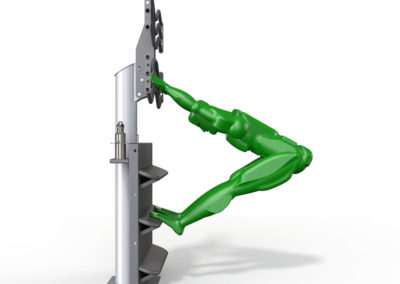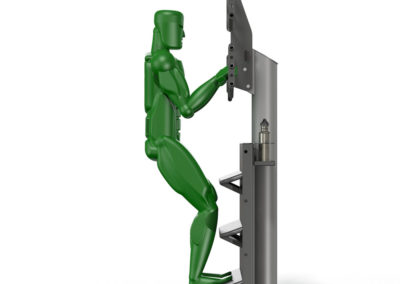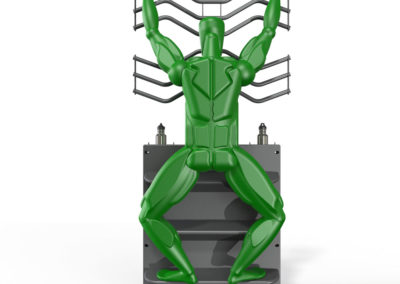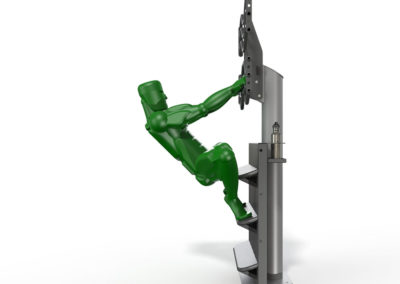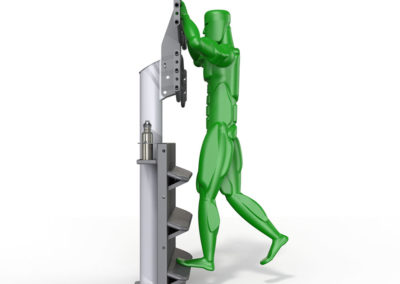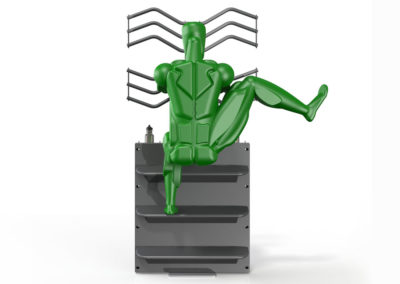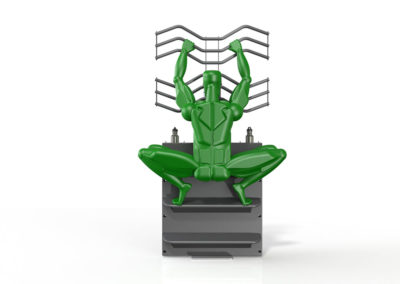
The Science of G-NAT™
Global Neuromuscular Activation Technology™ (G-NAT™) is the accumulation of nearly 2 decades of research and development. G-NAT™ is a patented product line, designed and developed by Brendle Systems, and takes exercise to the next level of science and technology. The mission of G-NAT™ is to improve the life of as many people as possible, by producing products that will be safer and more ergonomic for the body, and save precious time, being a sustainable exercise modality for everyone at all ages, sizes and condition levels. G-NAT™ is a personal exercise system that you do at your own pace and intensity. Results come fast with less time invested. Life is enjoyed outside the gym and rehab center, so spend less time in it. The following addresses the Science of Vertical Movement, discussing the Parasympathetic and Sympathetic Nervous Systems, the definition of Vertical Movement™ and it’s differences to Horizontal training. Benefits, EPOC, & Life Movements. Please feel free to contact us anytime to further discuss G-NAT™, and what it can do for you. The independent laboratory G-NAT Equipment And Effectiveness Review by Welltec Human Performance Lab, is available here..
Parasympathetic and Sympathetic Nervous Systems
You are in the parasympathetic nervous system normally. It is your relaxed or comfortable state because you are experiencing actions and forces that you have been conditioned to respond to consciously or by reflex (autonomic) action. The sympathetic nervous system is your guarded and survival state that is activated by either or both an emotional assumption or a physical confirmation of a threat. Examples of emotional “fear” triggered sympathetic responses would be the Flight-or-Fight and the Fear-of-Falling responses. Both may be referred to as an FOF response respectively. FOF responses are emotionally “fear” triggered and ultimately push the nervous system in and out of the sympathetic in a chaotic fashion until it is physically confirmed. The FOF responses are a fear response of the amygdala and results in many negative physiological side effects, such as cortisol production and negative adrenal response, along with elevated resting heart rates and a lower VO2 Max in order to defend itself. Prolonged exposure to emotionally “fear” triggered FOF responses can cause negative symptoms and result in neuroticism or PTSD to mention a couple. However, a clean physically triggered sympathetic response that is free of emotion produces none of the garbage and negative effects associated with FOF “fear” responses. Vertical Movement physically triggers the sympathetic response, which involuntarily activates all the same motor muscles globally as the FOF, making them ready for action and integrated with each other. Vertical Movement done properly programs the body to move and respond to forces faster and transition by cue to other muscles when back in the normal horizontal state. Additional benefits of training in the sympathetic nervous system are being discovered as trainers and medical practitioners learn to apply the proper G-NAT™ protocols of vertical training.
The Definition of Vertical Movement™
Exercise done on a vertical surface with only you as the means of attachment. Life Movements™ are specific vertical movement exercises and forms designed to produce a balanced whole body neuromuscular activation. Vertical Movement further defined: You cannot be attached to the vertical apparatus by straps, hooks, belts or anything other than your fingers and resting on the balls of your feet. There must be at least one finger (upper body connection) attached to the G-NAT™ apparatus to hold and maintain the body in its position in space. The torso must not be allowed to be over the top of the feet at any time. The potential for the fingers to detach triggers the sympathetic response. The autonomic nervous system recognizes the threat of angular force and the potentially abnormal direction of descent pivoting the body at the foot attachment point while descending, if the fingers fail to maintain attachment. A question often asked, is how high off the ground do you need to be to Vertically Train? Just high enough and with the angular force relationship between the torso and the foot that does not permit equilibrium and the autonomic nervous system recognizes and physically confirms a threat that is more than just momentary. You are no longer vertically training when the autonomic nervous system can recognize horizontal stability/equilibrium.


There Are Physiological Differences Between Vertical Movement™ & Horizontal Training
Horizontal exercise, although at times very intense are done with a maintained or attainable state of equilibrium, and done properly produces, no actual threat to the autonomic nervous system, and all said movements are recognized as normal. The body operates comfortably (normally) in the parasympathetic nervous system. When done properly, Vertical Movement, regardless to its intensity level, does not permit the body to establish a SAFE state of equilibrium. The central nervous system physically confirms a threat to the safety and survival of the body and switches into the sympathetic nervous system to operate in a guarded (protective) state. This sympathetic response is because of the recognizable muscle tensions in the upper extremities along with the inner ear’s inability to recognize and confirm normal horizontal stability or equilibrium. Part of the sympathetic response is the involuntary activation of all 603 motor muscles.
Benefits of Vertical Movement™
GNA/GMA: Global Neuromuscular Activation is the recognized term in the medical/rehab field, and Global Muscular Integration is the term recognized in sports and fitness fields. The advantage of global neuromuscular activation, as opposed to isolated and regional activation, is the coordinated response of complete tensional lines of muscles to applied forces. This delivers more combined resistance forces along and around the joint(s) to protect and stabilize them during static positioning or movement. GNA also improves the synergetic transition from one Myofascial or Tensional Line to another during movement as leverage forces shift position or change direction. This synergy results in more strength, power and coordination which improve overall speed and human performance. GEC: Global Energy Consumption is an inherent side effect of GNA. Vertical training is many times more efficient at burning/consuming glucose and fat stores than horizontal training because all the motor muscles of the body are involuntarily activated. All muscles are consuming approximately 1 watt of potential energy in this idle state. With the additional wattage consumption of recruited muscles for movement, the combined energy consumption per second, or minute, from training in a GNA state in considerably higher than with horizontal training. This translates into burning more fat in less time. Additional inherent benefits of Vertical Movement: Joint Decompression, Joint Stability, Coordination, Agility, Functional Core Stability and Strength, Time Efficiency, Improved blood circulation and Neurotransmission, Skeletal alignment and postural form, improved movement pathways and musculoskeletal balance.
Myofascial & Tensional Lines
“True functional training must incorporate one or more tensional lines in a movement or exercise to be applicable to everyday life,” Doug Brendle. A Myofascial Line is a contiguous line of connective tissue. Which typically starts somewhere on the torso and ends at the end of a limb or the head, or starts at one end of the torso and ends at the other end of the torso. In general, the torso is the common end of Myofascial lines. A Tensional Line is a contiguous line of connecting Myofascial Lines that begins at the head or a limb and runs through the torso and ends at the end of another limb. For example, starting at the right hand and ending at the right foot. G-NATs target and functional Tensional Lines are: Hand to Hand, Hand to Foot, Foot to Foot, Hand to Head and Head to Foot.
EPOC & Vertical Movement™
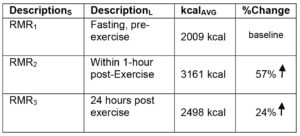 Excess Post-Exercise Oxygen Consumption or Extra Post Oxygen Consumption, for short. The excess oxygen consumed after exercise is from the continued conversion of glucose into energy. The EPOC after vertical training to a set protocol has been tested (See Effectiveness Review) and shown to uniquely increase the metabolism 57% one hour after exercise and 24% twenty-four hours after exercise. Because of the higher EPOC and the higher levels of caloric consumption resulting from GEC (Global Energy Consumption), vertical movement has the potential to consume many times more calories over a twenty-four hour period than any other exercise modality.
Excess Post-Exercise Oxygen Consumption or Extra Post Oxygen Consumption, for short. The excess oxygen consumed after exercise is from the continued conversion of glucose into energy. The EPOC after vertical training to a set protocol has been tested (See Effectiveness Review) and shown to uniquely increase the metabolism 57% one hour after exercise and 24% twenty-four hours after exercise. Because of the higher EPOC and the higher levels of caloric consumption resulting from GEC (Global Energy Consumption), vertical movement has the potential to consume many times more calories over a twenty-four hour period than any other exercise modality.
Movements
There are 12 G-NAT Life Movements™ and 3 G-NAT Dynamic Movements™ for a total of 15 G-NAT Movements™ that make up the core group of movements. In addition, there are countless optional, occupational and sports specific G-NAT Movements™ that can be performed for focused and intentional results. Of the 15 core movements, the initial group is the 12 Life Movements™ and they were designed and developed to equally exhaust all the muscles in the body respectively from the shoulders down. These movements done properly will ensure that potentially every muscle is extended and contracted, therefore flushed and fortified. Any weak links of the body’s tensional lines are exposed, and progressively strengthened, and tensional lines are systematically integrated with each other for synergetic movement and response in everyday life.
Sustainability
Because of the decompressive nature of the Life Movements™ when done properly, Life Movements™ can be done consistently and safely from the age of one to over one hundred. From age one to maturity, a person can exercise effectively and enjoy the benefits of the Life Movements™ with no threat to the growth plates. From maturity into our senior years, exercise can be done without damage to the joints. The benefits of joint decompression can offer pain relief to those who have experienced damage to their joints by decompressing the joints during exercise and increasing blood flow. This allows strengthening of the stabilization muscles without sacrificing the joints. With Life Movements™ done properly, people with bone-on-bone joint issues may consistently perform less painful, and potentially pain free, movements/exercises. Traditional (horizontal) exercises create compressive forces on the joint(s), and in most cases cannot be done without extreme pain and increased damage to the joints. Therefore traditional exercises may not be sustained for any long period time. Vertical Movements have not been shown to create negative cortisol production or adrenal response, therefore the consistent and long-term practice has not been seen to produce the typical negative effects that would eventually cause a person to discontinue their exercise modality.
